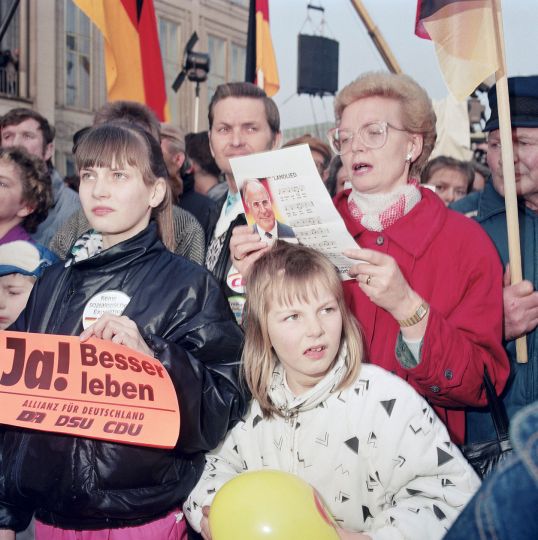
Transition 1989 – 1990
The images of the series were taken shortly after the fall of the Berlin Wall. They show former East-Germany in a period of backpedaling and at the same time in a state of transformation.
Julie Knaga, CNN, October2014
‘One country, two different worlds’
On October 3, 1990, fireworks lit up the Berlin sky.
The Wall had fallen.
Travel restrictions had lifted.
The German Democratic Republic had officially acceded.
For the first time since Germany was divided at the close of World War II, East and West were reunited under one name.
“The reunification was much more than that,” remembers German photographer Wolfgang Bellwinkel. “It was the end of the Cold War and definitely a milestone in modern history and definitely a big change for Europe, for our feelings and our attitude towards our neighbors in the East and even Russia.”
Bellwinkel grew up in a middle-class family in West Germany, and he said he was not particularly interested in life on the other side of the Iron Curtain when he was younger.
“I think it’s a generation thing, that we just accepted the division of Germany as a result — maybe some kind of punishment — of the second World War,” he said. “At that time, I always thought that Holland or France was somehow more familiar to me than the GDR.”
But as Germany came together, Bellwinkel developed a growing interest in his secluded neighbors to the East.
He documented Germany’s reunification in a collection called “Wendezeit,” which roughly translated means “transition period.” The photographs date from shortly after the fall of the Berlin Wall, in November 1989, to reunification celebrations about one year later.
“They show one country but two very different worlds,” he said.
Juxtaposed against crowded scenes of East Germans shopping for Western goods and cheering during unity celebrations are photographs of desolate landscapes and relics from decades of East German isolation and economic stagnation.
One of Bellwinkel’s favorite photographs in the collection is that of two East German border police letting a “Trabi” car pass through a gate to attend a wall-opening celebration.
Trabants, or Trabis as they were called, were one of the most recognizable symbols of East Germany. Dubbed “the people’s car,” these GDR-produced vehicles were touted as simple, durable and easy to repair.
In actuality, Trabants generally lacked even basic features, such as brake lights. The cars were constructed out of Duroplast, a type of plastic made from glue and recycled fibers. Orders for one would often take 10 years to fulfill.
After the fall of the Berlin Wall, thousands of East Germans used their Trabis to journey across the border, many abandoning their cars somewhere along the way.
October 3 is now a national holiday, the Day of German Unity. Germans still commemorate the event with festivals and fireworks, but so much else has changed since 1990.
After more than two decades, Bellwinkel believes his photos are a historical witness to not just a moment in history but a past world that would otherwise be forgotten.
Berliner Morgenpost 05.10.2009 anläßlich der Ausstellung Spuren und Szenen eines Falls im Max-Liebermann-Haus, Berlin
… Erst 20 Jahre liegt einer der bedeutendsten Momente unserer Geschichte zurück, doch manches scheint längst anachronistisch. Dazu zählen sicher auch die Bilder aus der Serie “Wendezeit” von Wolfgang Bellwinkel, Jahrgang 1959. Er widmet sich gewissermaßen den skurrilen Momenten der Vereinigung. Dort sehen wir, wie im Frühjahr 1990 ostdeutsche Grenzer in Thüringen auf dem Land DDR-“Ausflügler” durch ein Maschendrahtzaun-Tor passieren lassen. Etwas unbeholfen stehen sie da ob der neuen Freiheit, so, als würden sie eine Scheune öffnen und keine ehemalige Grenze, die von Todesschützen bewacht war. Abends schließen sie den Übergang mit einem simplen Vorhängeschloss. Das ist so banal wie zynisch, je nach Sichtweise. Und der leere Wachposten aus Holz wirkt nun wie ein idyllisches Gartenhäuschen für das Datschengrundstück in Pankow…
Der Tagesspiegel 06.10.2009
… Kurator Matthias Harder von der Helmut Newton Foundation ist sich der Gefahr des Sattsehens bewusst, wenn er betont, dass er nach „ungesehenen“ Bildern gesucht hat. Das ist ihm gelungen. Skurril ist die Bilderserie Wolfgang Bellwinkels. Der Fotograf hielt den Tagesablauf an einer Grenze in Thüringen fest: Morgens dürfen DDR-Ausflügler begleitet von Blasmusik die Grenze passieren, abends wird hinter ihnen wieder abgeschlossen – mit Vorhängeschloss. Monate nach den Umbrüchen im fernen Berlin…



















































